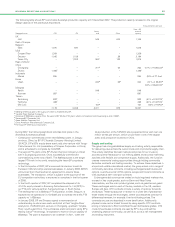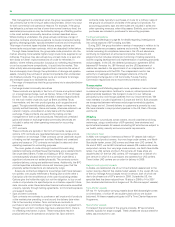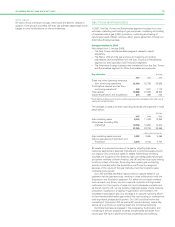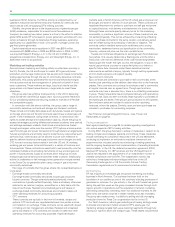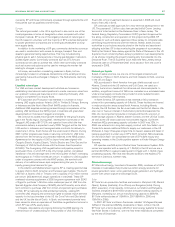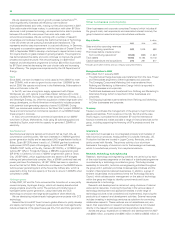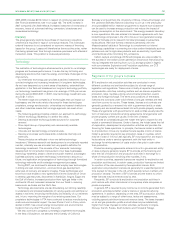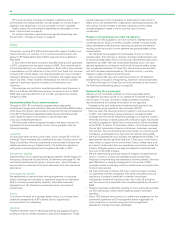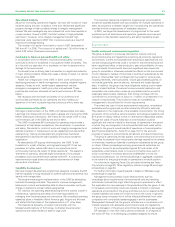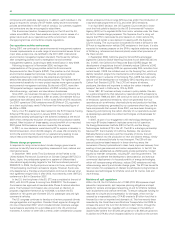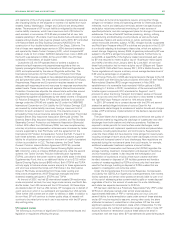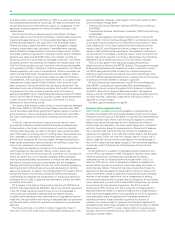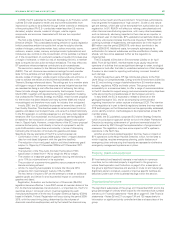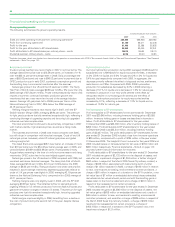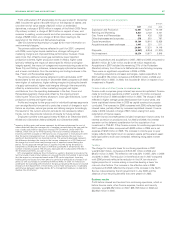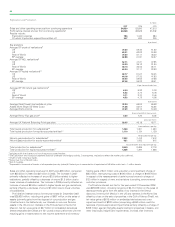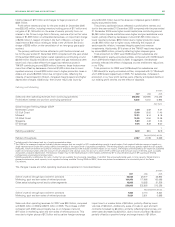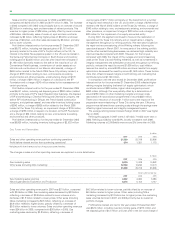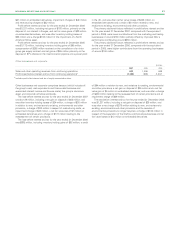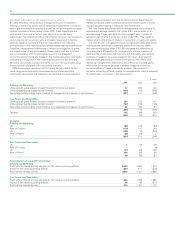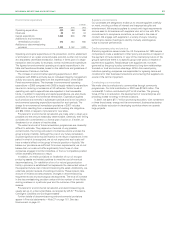BP 2007 Annual Report Download - page 45
Download and view the complete annual report
Please find page 45 of the 2007 BP annual report below. You can navigate through the pages in the report by either clicking on the pages listed below, or by using the keyword search tool below to find specific information within the annual report.
BP ANNUAL REPORT AND ACCOUNTS 2007 43
and operators of the carrying vessel, some states implemented statutes
also imposing liability on the shippers or owners of oil spilled from such
vessels. Alaska, Washington, Oregon and California are among these
states. The exposure of BP to such liability is mitigated by the vessels’
marine liability insurance, which has a maximum limit of $1 billion for
each accident or occurrence. OPA 90 also provides that all new tank
vessels operating in US waters must have double hulls and existing tank
vessels without double hulls must be phased out by 2015. BP contracted
with National Steel and Ship Building Company (NASSCO) for the
construction of four double-hulled tankers in San Diego, California. The
first of these new vessels began service in 2004, demise-chartered to
and operated by Alaska Tanker Company (ATC), which transports BP
Alaskan crude oil from Valdez. NASSCO delivered two more in 2005 and
the fourth was delivered in 2006. At the end of 2007, the ATC fleet
consisted of five tankers, all double-hulled.
Outside the US, the BP-operated fleet of tankers is subject to
international spill response and preparedness regulations that are
typically promulgated through the International Maritime Organization
(IMO) and implemented by the relevant flag state authorities. The
International Convention for the Prevention of Pollution from Ships
(Marpol 73/78) requires vessels to have detailed ship-board emergency
and spill prevention plans. The International Convention on Oil Pollution,
Preparedness, Response and Co-operation requires vessels to have
adequate spill response plans and resources for response anywhere the
vessel travels. These conventions and separate Marine Environmental
Protection Circulars also stipulate the relevant state authorities around
the globe that require engagement in the event of a spill. All these
requirements together are addressed by the vessel owners in Shipboard
Oil Pollution Emergency Plans. BP Shipping’s liabilities for oil pollution
damage under the OPA 90 and outside the US under the 1969/1992
International Convention on Civil Liability for Oil Pollution Damage (CLC)
are covered by marine liability insurance, having a maximum limit of
$1 billion for each accident or occurrence. This insurance cover is
provided by three mutual insurance associations (P&I Clubs): The United
Kingdom Steam Ship Assurance Association (Bermuda) Limited; The
Britannia Steam Ship Insurance Association Limited; and The Standard
Steamship Owners’ Protection and Indemnity Association (Bermuda)
Limited. With effect from 20 February 2006, two new complementary
voluntary oil pollution compensation schemes were introduced by tanker
owners, supported by their P&I Clubs, with the agreement of the
International Oil Pollution Compensation Fund at the IMO. Pursuant to
both these schemes, tanker owners will voluntarily assume a greater
liability for oil pollution compensation in the event of a spill of persistent
oil than is provided for in CLC. The first scheme, the Small Tanker
Owners’ Pollution Indemnification Agreement (STOPIA), provides
for a minimum liability of 20 million Special Drawing Rights (around
$30 million) for a ship at or below 29,548 gross tons, while the second
scheme, the Tanker Owners’ Pollution Indemnification Agreement
(TOPIA), provides for the tanker owner to take a 50% stake in the 2003
Supplementary Fund, that is, an additional liability of up to 273.5 million
Special Drawing Rights (around $430 million). Both STOPIA and TOPIA
will only apply to tankers whose owners are party to these agreements
and who have entered their ships with P&I Clubs in the International
Group of P&I Clubs, so benefiting from those clubs’ pooling and
reinsurance arrangements. All BP Shipping’s managed and time-
chartered vessels participate in STOPIA and TOPIA.
At the end of 2007, we had 53 international vessels (39 medium-size
crude and product carriers, four very large crude carriers, one North Sea
shuttle tanker, five LNG carriers and four LPG carriers). All these ships
are double-hulled. Of the five LNG carriers, BP manages one on behalf of
a joint venture in which it is a participant and operates four LNG carriers.
Three further LNG carriers are on order for delivery in 2008. In addition to
its own fleet, BP will continue to charter quality ships; all vessels will
continue to be vetted prior to each use in accordance with the BP group
ship vetting policy.
US regional review
The following is a summary of significant US environmental issues and
legislation or regulations affecting the group.
The Clean Air Act and its regulations require, among other things,
stringent air emission limits and operating permits for chemicals plants,
refineries, marine and distribution terminals; stricter fuel specifications
and sulphur reductions; enhanced monitoring of major sources of
specified pollutants; and risk management plans for storage of hazardous
substances. This law affects BP facilities producing, storing, refining,
manufacturing and distributing oil and products as well as the fuels
themselves. Federal and state controls on ozone, particulate matter,
carbon monoxide, benzene, sulphur, MTBE, nitrogen dioxide, oxygenates
and Reid Vapor Pressure affect BP’s activities and products in the US. BP
is continually adapting its business to these rules, which are subject to
recent change. Beginning January 2006, all gasoline produced by BP was
subject to the EPA’s stringent low-sulphur standards. Furthermore, by
June 2006, at least 80% of the highway diesel fuel produced each year
by BP was required to meet a sulphur cap of 15 parts per million (ppm)
and 100% with effect from January 2010. By June 2007, all non-road
diesel fuel production had to meet a sulphur cap of 500ppm and 15ppm
by June 2012. With effect from January 2011, EPA’s Mobile Source Air
Toxics regulations will require a refinery annual average benzene level of
0.62 volume percentage on all gasoline.
The Energy Policy Act of 2005 also required several changes to the US
fuels market with the following fuel provisions: elimination of the Federal
Reformulated Gasoline (RFG) oxygen requirement in May 2006;
establishment of a renewable fuels mandate (4 billion gallons in 2006,
increasing to 7.5 billion in 2012); consolidation of the summertime RFG
Volatile organic compound (VOC) standards for Regions 1 and 2;
provision to allow the Ozone Transport Commission states on the east
coast to opt any area into RFG; and a provision to allow states to repeal
the 1psi Reid Vapor Pressure waiver for 10% ethanol blends.
In 2001, BP entered into a consent decree with the EPA and several
states that settled alleged violations of various Clean Air Act
requirements related largely to emissions of sulphur dioxide and nitrogen
oxides at BP’s refineries. Implementation of the decree’s requirements
continues.
The Clean Water Act is designed to protect and enhance the quality of
US surface waters by regulating the discharge of wastewater and other
discharges from both onshore and offshore operations. Facilities are
required to obtain permits for most surface water discharges, install
control equipment and implement operational controls and preventative
measures, including spill prevention and control plans. Requirements
under the Clean Water Act have become more stringent in recent years,
including coverage of storm and surface water discharges at many more
facilities and increased control of toxic discharges. New regulations are
expected during the next several years that could require, for example,
additional wastewater treatment systems at some facilities.
The Resource Conservation and Recovery Act (RCRA) regulates the
storage, handling, treatment, transportation and disposal of hazardous
and non-hazardous wastes. It also requires the investigation and
remediation of locations at a facility where such wastes have been
handled, released or disposed of. BP facilities generate and handle a
number of wastes regulated by RCRA and have units that have been
used for the storage, handling or disposal of RCRA wastes that are
subject to investigation and corrective action.
Under the Comprehensive Environmental Response, Compensation
and Liability Act (CERCLA or Superfund), waste generators, site owners,
facility operators and certain other parties are strictly liable for part or all
of the cost of addressing sites contaminated by spills or waste disposal
regardless of fault or the amount of waste sent to a site. Additionally,
each state has separate laws similar to CERCLA.
BP has been identified as a Potentially Responsible Party (PRP) under
CERCLA or otherwise named under similar state statutes at
approximately 805 sites. A PRP or named party can incur joint and
several liability for site remediation costs under some of these statutes
and so BP may be required to assume, among other costs, the share
attributed to insolvent, unidentified or other parties. BP has the most
significant exposure for remediation costs at 52 of these sites. For the
remaining sites, the number of parties can range up to 200 or more. BP
expects its share of remediation costs at these sites to be small in
comparison with the major sites. BP has estimated its potential exposure


